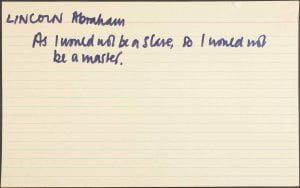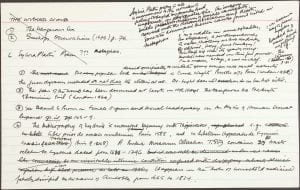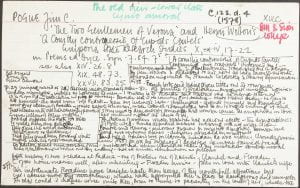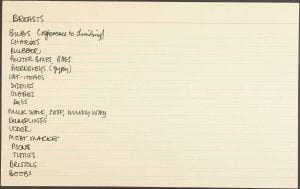
Mindswap: The Female Eunuch Index Cards
By Rachel Buchanan, Curator, Germaine Greer Archive
The first card is written in a black Texta that has faded, 47 years on, to a bruised purple. In the top left-hand corner the young academic has written LINCOLN Abraham. Underneath it, the quote: “As I would not be a slave, so I would not be a master.”
On the last card the word Culture is written in capitals in red pen in the top left-hand corner. Underneath is a typed reference, LESSING, DORIS, Children of Violence.

In between Lincoln and Lessing, there are 551 double-sided index cards in three solid bundles. The creator of the cards, Germaine Greer, has labelled the first one “early research for The Female Eunuch from drawer 42” and the other two “More research for The Female Eunuch from drawer 42”.
The cards are arranged as they were received by the University of Melbourne Archives in 2014. The system is anti-system. The order is neither alphabetical nor chronological. It is not based on subject, quotes or genre either. The Female Eunuch is broken into five idiosyncratic sections – Body, Soul, Love, Hate and Revolution – and each section is divided into sub-sections or chapters (wicked womb, energy, baby, womanpower, loathing and disgust are some of the 29 suggestive titles). Many cards reference sections or chapter headings. Some match references in the Notes section or the boxed quotes inserted in bold in the text but others are harder to place. Bullshit Action, Sexuality, Witchery-Soul, Soul-Corporate Feeling, Abstinence, Unisex and Obsession do not appear on the contents page.
The words that best apply to the arrangement and content of cards are the ones that Greer used herself in a typed summary presented 47 years ago to Sonny Mehta, the commissioning editor for MacGibbon and Kee (an imprint of Granada Publishing). According to Greer’s Warwick University diary, the pair met at Golden Square, Soho on 17 March 1969 and again a few weeks later. Saw Sonny. Gave him synopsis. Talked til 5am, reads the entry for 29 March.
At one of these meetings, Greer gave Mehta a 3-page typed synopsis that proposed a collection of essays on what it was like to be a woman in 1969. The project would be organic, experimental, sensational and outrageous. The language would be accurate, sensual and direct.
The typescript with emendations and additions in Greer’s hand has been published on the University of Melbourne’s library digital collections repository along with other early fragments of the book, including typescripts, chapter drafts and handwritten notes.
Now the index cards have been digitised and published too. You can find them by going to the University of Melbourne Archives website and typing the series number 2014.0039 into the “search digitised items” search box.
Material culture students Chloe Pagaduan and Emma Adams worked part-time for several months to catalogue each card. They scoured the pages of The Female Eunuch and its Notes section hunting for matches with the material on the index cards. They also researched incomplete sources and the specialities of some key authors. Their well-thumbed paperback copies of The Eunuch are dotted with sticky notes and dog ears, a testament to their meticulous volunteer labour.

The index cards plot Greer’s anarchic reading and ideas offer scholars new insights into the extraordinarily eclectic scholarly, popular and counterculture sources behind The Female Eunuch (1970), one of the twentieth century’s most influential books.
“The cards are material evidence of the painstaking research Greer did and they provide an insight into her unique creative process,” Pagaduan says. “They are invaluable and irreplaceable.”
Along with carbon copies of typescripts and handwritten summaries of early versions of book, the articles Greer wrote for the underground press and her lecture notes from Warwick University, the index cards are witnesses to the explosion of radical ideas – historical and modern – that fuelled this book.
The cards are part of the complex backstory to The Eunuch and they need to be read carefully.
In response to a query from UMA, Greer has suggested that further investigation is needed into the timing of the creation of the index file. The first draft of the Female Eunuch may have been written without index cards. Could some of the cards have been created, collaboratively, in response to queries from the fact-checkers for McGraw Hill, the Female Eunuch’s first American publishers? This question raises the intriguing possibility that the cards were not only a way for Greer to organise her research but also became a tool to support publication and republication, deal with copyright permissions and provide source material for further writing, publicity and debate.
Were the cards created in stages, rather than in one continuous burst of pre-writing research? Certainly, the index cards in the first bundle – which are crammed with notes – are quite different documents from many in the last which comprise just an author’s name and book title.
The chronology for the creation of the cards still needs to be reconstructed in a scholarly way from other sources in the archive, such as correspondence with the book’s first English and American publishers and other bibliographical evidence, such as the call numbers scrawled on some cards. Which library or libraries do they match?

What the cards clearly demonstrate is that Greer was reaching for an astonishing range of contemporary and historical sources and she was working very quickly in between many other commitments.
The Female Eunuch was published only 18 months after Greer first discussed it with Sonny Mehta. In that time, Greer was also a lecturer in English at Warwick University. She continued to write articles for OZ and other underground magazines and until May 1969 she spent two days a week in Manchester filming episodes of Granada TV’s Nice Time with Kenny Everett. She also wrote a proposal for a film called The Groupie.
The cards are not a product of scholarly contemplation. They carry the whiff of burnt rubber; they are evidence of speed, fervour, the reckless stunt. Energy still fizzes from them. As objects, they demand respect, inspire awe and invite contemplation of the labour (and paper) involved in pre-internet research methods, including flicking through drawers of card catalogues, browsing the shelves in libraries and handwriting or typing bibliographical information. There was no EndNote or Scrivener in 1969.
The cards’ dimensions (a standard 230mm by 127mm) are the only thing that is uniform about them. Some are yellow, some white, a few are blue or pale pink. Some are typed, most are handwritten. Some are written in blue ink then more words are inserted in red and then there are notes on the notes, spidering up the margin in green. Phrases are circled in violet. Smoke Gets in Your Eyes. Song. Nat King Cole. A few scraps from Sylvia Plath climb towards a card’s right tip. Tiny little jottings on diseases of the vulva and vagina are dotted across another.
Most written are in English but one contains notes in Latin. Others are in German, Italian, French or old English. There are proverbs. A woman without ability is normal, said the Chinese. There are statistics. Phone numbers for friends. And lists. Breasts. Bubs (reference to drinking). Charlies. Blubber. Butter bixes, bags. Berkeveys (Gypsy). Cat heads. Diddies. Globes. Dugs. Milk walk, shop, milky way. Dumplings. Udder. Meat Market. Poont. Titties. Bristols. Boobs. Other lists contain language that is more X-rated, poetic and enraged. The text on these free-association, rant cards can be read aloud as spoken word. The list of synonyms for cunt is particularly fruity.
Some cards are blank but for a title that has been struck out anyway. Humour exists in many of the cards, even in the empty ones. Card 163 is labelled Rebellion. There’s nothing on either side. Ditto for Marriage and Family.
Greer’s knack for succinct decimation is display in card 94, a reference to Kenneth Walker’s Sexual Behaviour Creative and Destructive (1996). Arrant nonsense all of it. Can’t be bothered. Card 168, on The Single Woman (1934) by R L Dickinson and Lura Beam, Greer writes: Awful, awful book … whole book a chamber of horrors! Card 84 fries E Neumann’s work as collective unconscious nonsense.
Although Greer’s research was not for a PhD thesis (she was awarded hers in 1968 and those index cards are also in the Greer Archive) these two acerbic Eunuch cards are examples of what Italian novelist and philosopher Umberto Eco calls the “disposal index card”. These ones remind a writer that they do not need a particular source.
Eco was something of an index card expert. In How to Write a Thesis (1977) he discusses 13 different types, including the disposal index cards, the polemical index card, the review one, the thematic one and the tantalising “mindswap” (the card created via an exchange of information with another student).
MIT Press published a new edition of Eco’s book in 2015 and the chapter on “the work plan and the index cards” evokes nostalgia for this simple, flexible and once ubiquitous method of ordering, reordering and synthesising your research and your thoughts.
Botanist Carl Linnaeus, best known for his system of classifying plants and animals, invented the index card in about 1760. By the end of the eighteenth century, scientists, librarians and administrators were all using them to record and store information. Library card catalogues, using the Dewey decimal system, arrived in 1870.
Index cards can be shuffled, filed, flipped or laid flat like a hand of patience (or memory). They can be re-ordered as often as a researcher likes, allowing ideas to find new companions in the stack. It is a radically open system of storing ideas.
Writing in the American art journal October (2005) Professor Denis Holler of New York University describes the index card as a filing system that is “indefinitely expandable, rhizomatic (at any point of time or space, one can always insert a new card)”. Unlike the pages of a book or notebook, an index card file can be permanently reordered. Semiotician Roland Barthes was a devotee as was surrealist Michel Leiris a generation earlier. Barthes’ archive contains 12,250 index cards.
Novelist Vladimir Nabokov wrote Lolita, Pale Fire and other novels in pencil, on index cards. He copied, expanded and rearranged the cards to make his books. “The pattern of the thing precedes the thing,” he told Herbert Gold of The Paris Review in 1967. “I fill in the gaps of the crossword at any spot I happen to choose. These bits I write on index cards until the novel is done.”
Nabokov’s last novel The Original of Laura existed only as a “handwritten melange of notes on 138 index cards”, according to Alexander Theroux (2013). Nabokov died in 1977 and his wife Vera in 1991. The writer told Vera to burn the cards but she locked them in a Swiss bank vault instead. In 2009, the writer’s son Dmitri allowed Knopf and Penguin to publish the unfinished novel, complete with duplicates of the cards that readers could tear out and reshuffle.

Greer’s index cards encompass the scholarly, creative, library, scientific and administrative purposes that these objects have been put to plus a few new groovy late 1960s ones. Is there any other collection of secular index cards that uses the word Soul more often?
She has created them for many of her books; the entire index card collection occupies 11 heavy oblong boxes at the University of Melbourne Archives. The first lot was made around 1968 – the references for Greer’s reading for her doctorate on early Shakespearean comedy – and the most recent are the cards for Shakespeare’s Wife (2007). The index cards on women painters and artists comprises thousands of cards packed into five boxes; a monumental act of feminist bibliographic research in and of itself.
The Female Eunuch cards have a box to themselves (7) and they only occupy half of it. They are literary artefacts in their own right. Reading them is like eavesdropping on the late 1960s counterculture. The text on the cards is exciting, unsettling, anarchic, rude, radical and occasionally ludicrous. Jung, nineteenth century sexologists, contemporary dating manuals are all mixed up together. Card 30 cites AW Watts Man and Woman (1958) on the front, and then quotes Freud. On the back Greer has handwritten a passage from Lao-Tzu’s Tao de Ching.
Card 9 has a typed reference to FREUD Sigmund and notes on his Introductory Lectures in Psycho analysis (1922). The card’s title, in red felt tip, is Psychology – Love – see over. Beneath the typed title, Greer breaks into a loose cursive handwriting. Male + female dream symbols. Smooth house sticks umbrellas, poles, knives, daggers, lances, sabres, guns, pistols, revolvers, taps, watering cans, springs, pulley, lamps, pencils – sheath, nail files, hammer etc, balloons, aeroplanes, zeppelins flying = erection. Beneath a quote from Freud is another list. Wood, paper, churches, chapels, apples, peaches, fruit, sexual organs – landscape, shoes, slippers…
It’s one of the many wild cards in this feral pack.
Categories
The cards really do offer wonderful insight into the research undertaken by Greer to compile her book. A fascinating cultural collection! Really enjoyed reading this.
Thank you for this blog post. I am stimulated both by the excellent blog piece and the notion of index card series as being a a further evidence of Greer’s radical intelligence.
I was in my mid-teens when The Female Eunuch was first published in Australia. Impatient to read the book, I waited in line behind my mother and grandmother for my turn. This mind-exploding read instigated the forming of a book group by my mother and her peers. They meet over time to discuss, chapter by chapter, their personal, political and intellectual responses to the book.
As the youngest reader, I sat in with the other members who came from a diversity of age, education and background; what we did have in common was being female in Melbourne, Australia in 1970.
This book spoke loudly; with extraordinary and often poetic articulation about what we knew and did not know about being women. I look forward to accessing this exciting and important digital series.
Hi Rachel
What a corker of a post. Thank you! Echoing here the recommendations from Joanna Sassoon and Michael Piggott. This made my day. Just wonderful stuff
barbara